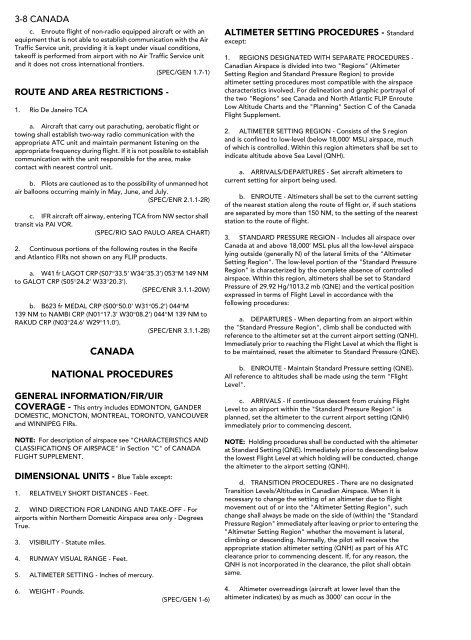NORTH AND SOUTH AMERICA - CNATRA - The US Navy
NORTH AND SOUTH AMERICA - CNATRA - The US Navy
NORTH AND SOUTH AMERICA - CNATRA - The US Navy
You also want an ePaper? Increase the reach of your titles
YUMPU automatically turns print PDFs into web optimized ePapers that Google loves.
3-8 CANADA<br />
c. Enroute flight of non-radio equipped aircraft or with an<br />
equipment that is not able to establish communication with the Air<br />
Traffic Service unit, providing it is kept under visual conditions,<br />
takeoff is performed from airport with no Air Traffic Service unit<br />
and it does not cross international frontiers.<br />
(SPEC/GEN 1.7-1)<br />
ROUTE <strong>AND</strong> AREA RESTRICTIONS -<br />
1. Rio De Janeiro TCA<br />
a. Aircraft that carry out parachuting, aerobatic flight or<br />
towing shall establish two-way radio communication with the<br />
appropriate ATC unit and maintain permanent listening on the<br />
appropriate frequency during flight. If it is not possible to establish<br />
communication with the unit responsible for the area, make<br />
contact with nearest control unit.<br />
b. Pilots are cautioned as to the possibility of unmanned hot<br />
air balloons occurring mainly in May, June, and July.<br />
(SPEC/ENR 2.1.1-2R)<br />
c. IFR aircraft off airway, entering TCA from NW sector shall<br />
transit via PAI VOR.<br />
(SPEC/RIO SAO PAULO AREA CHART)<br />
2. Continuous portions of the following routes in the Recife<br />
and Atlantico FIRs not shown on any FLIP products.<br />
a. W41 fr LAGOT CRP (S07°33.5’ W34°35.3’) 053°M 149 NM<br />
to GALOT CRP (S05°24.2’ W33°20.3’).<br />
(SPEC/ENR 3.1.1-20W)<br />
b. B623 fr MEDAL CRP (S00°50.0’ W31°05.2’) 044°M<br />
139 NM to NAMBI CRP (N01°17.3’ W30°08.2’) 044°M 139 NM to<br />
RAKUD CRP (N03°24.6’ W29°11.0’).<br />
(SPEC/ENR 3.1.1-2B)<br />
CANADA<br />
NATIONAL PROCEDURES<br />
GENERAL INFORMATION/FIR/UIR<br />
COVERAGE - This entry includes EDMONTON, G<strong>AND</strong>ER<br />
DOMESTIC, MONCTON, MONTREAL, TORONTO, VANCOUVER<br />
and WINNIPEG FIRs.<br />
NOTE: For description of airspace see "CHARACTERISTICS <strong>AND</strong><br />
CLASSIFICATIONS OF AIRSPACE" in Section "C" of CANADA<br />
FLIGHT SUPPLEMENT.<br />
DIMENSIONAL UNITS - Blue Table except:<br />
1. RELATIVELY SHORT DISTANCES - Feet.<br />
2. WIND DIRECTION FOR L<strong>AND</strong>ING <strong>AND</strong> TAKE-OFF - For<br />
airports within Northern Domestic Airspace area only - Degrees<br />
True.<br />
3. VISIBILITY - Statute miles.<br />
4. RUNWAY VISUAL RANGE - Feet.<br />
5. ALTIMETER SETTING - Inches of mercury.<br />
6. WEIGHT - Pounds.<br />
(SPEC/GEN 1-6)<br />
ALTIMETER SETTING PROCEDURES - Standard<br />
except:<br />
1. REGIONS DESIGNATED WITH SEPARATE PROCEDURES -<br />
Canadian Airspace is divided into two "Regions" (Altimeter<br />
Setting Region and Standard Pressure Region) to provide<br />
altimeter setting procedures most compatible with the airspace<br />
characteristics involved. For delineation and graphic portrayal of<br />
the two "Regions" see Canada and North Atlantic FLIP Enroute<br />
Low Altitude Charts and the "Planning" Section C of the Canada<br />
Flight Supplement.<br />
2. ALTIMETER SETTING REGION - Consists of the S region<br />
and is confined to low-level (below 18,000’ MSL) airspace, much<br />
of which is controlled. Within this region altimeters shall be set to<br />
indicate altitude above Sea Level (QNH).<br />
a. ARRIVALS/DEPARTURES - Set aircraft altimeters to<br />
current setting for airport being used.<br />
b. ENROUTE - Altimeters shall be set to the current setting<br />
of the nearest station along the route of flight or, if such stations<br />
are separated by more than 150 NM, to the setting of the nearest<br />
station to the route of flight.<br />
3. ST<strong>AND</strong>ARD PRESSURE REGION - Includes all airspace over<br />
Canada at and above 18,000’ MSL plus all the low-level airspace<br />
lying outside (generally N) of the lateral limits of the "Altimeter<br />
Setting Region". <strong>The</strong> low-level portion of the "Standard Pressure<br />
Region" is characterized by the complete absence of controlled<br />
airspace. Within this region, altimeters shall be set to Standard<br />
Pressure of 29.92 Hg/1013.2 mb (QNE) and the vertical position<br />
expressed in terms of Flight Level in accordance with the<br />
following procedures:<br />
a. DEPARTURES - When departing from an airport within<br />
the "Standard Pressure Region", climb shall be conducted with<br />
reference to the altimeter set at the current airport setting (QNH).<br />
Immediately prior to reaching the Flight Level at which the flight is<br />
to be maintained, reset the altimeter to Standard Pressure (QNE).<br />
b. ENROUTE - Maintain Standard Pressure setting (QNE).<br />
All reference to altitudes shall be made using the term "Flight<br />
Level".<br />
c. ARRIVALS - If continuous descent from cruising Flight<br />
Level to an airport within the "Standard Pressure Region" is<br />
planned, set the altimeter to the current airport setting (QNH)<br />
immediately prior to commencing descent.<br />
NOTE: Holding procedures shall be conducted with the altimeter<br />
at Standard Setting (QNE). Immediately prior to descending below<br />
the lowest Flight Level at which holding will be conducted, change<br />
the altimeter to the airport setting (QNH).<br />
d. TRANSITION PROCEDURES - <strong>The</strong>re are no designated<br />
Transition Levels/Altitudes in Canadian Airspace. When it is<br />
necessary to change the setting of an altimeter due to flight<br />
movement out of or into the "Altimeter Setting Region", such<br />
change shall always be made on the side of (within) the "Standard<br />
Pressure Region" immediately after leaving or prior to entering the<br />
"Altimeter Setting Region" whether the movement is lateral,<br />
climbing or descending. Normally, the pilot will receive the<br />
appropriate station altimeter setting (QNH) as part of his ATC<br />
clearance prior to commencing descent. If, for any reason, the<br />
QNH is not incorporated in the clearance, the pilot shall obtain<br />
same.<br />
4. Altimeter overreadings (aircraft at lower level than the<br />
altimeter indicates) by as much as 3000’ can occur in the

















